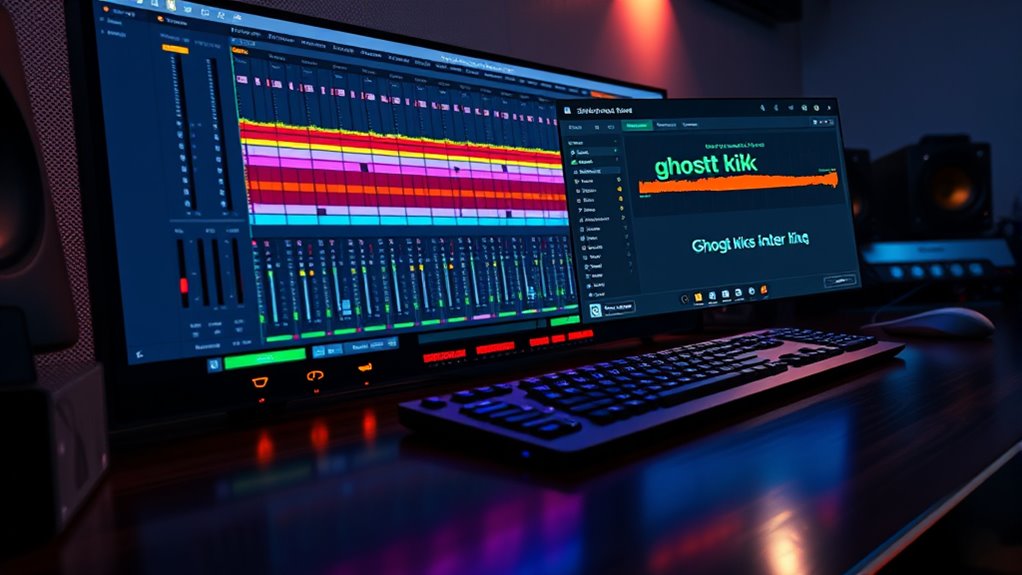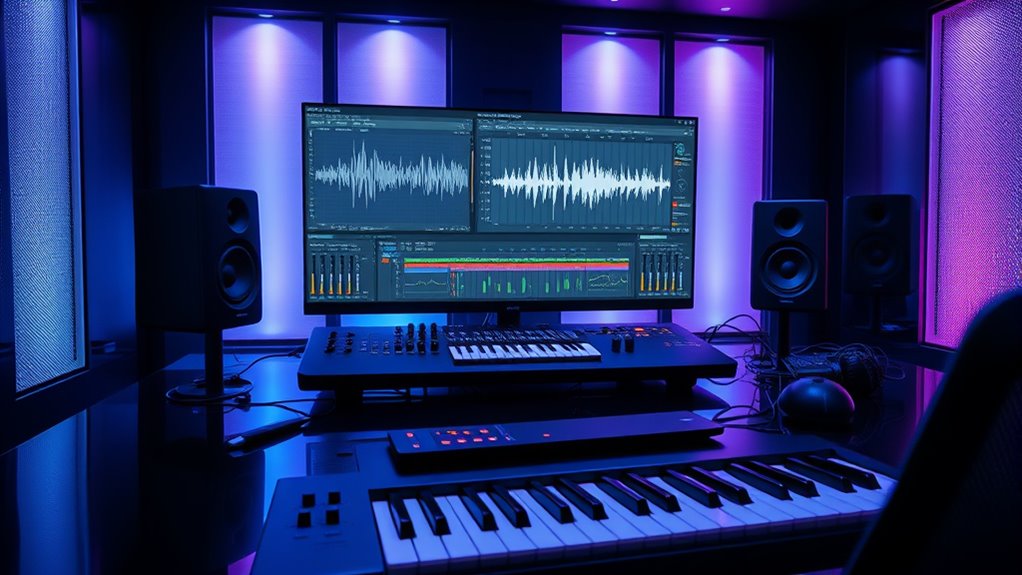To achieve club-ready dynamics using a ghost kick, you’ll set up a sidechain trigger that ducks your bass or melodic elements when the kick hits, creating space and punch. This hidden kick acts as a rhythmic cue without adding noise, ensuring your mix stays tight and energetic. Fine-tuning attack, release, and threshold makes the groove feel natural and powerful. Keep exploring how to craft and optimize ghost kicks for professional results.
Key Takeaways
- Sidechaining to a ghost kick creates rhythmic space and punch, ensuring bass and drums remain clear and impactful.
- Properly designed ghost kicks trigger compression precisely on the beat, enhancing groove and maintaining timing accuracy.
- Using volume envelopes or transient generators for ghost kicks allows seamless, club-ready dynamics without added noise.
- Adjust attack and release settings to achieve natural ducking, preventing unwanted pumping and preserving energy flow.
- Fine-tuning ghost kick triggers and sidechain parameters results in a cohesive, energetic mix ideal for dance and club tracks.
Understanding the Purpose of Sidechaining in Dance Music

Sidechaining is a key technique in dance music that helps create space and rhythm within a mix. When you sidechain, you automatically duck or lower the volume of certain sounds, usually basslines or pads, in response to a rhythmic element like a kick drum. This process guarantees that the kick stands out clearly, giving your track that punchy, driving feel essential for dance floors. It also prevents frequency clashes, making the mix sound cleaner and more balanced. By controlling how elements interact dynamically, sidechaining adds groove and motion to your music. Fundamentally, you’re shaping the energy flow, ensuring each element hits at the right moment without overwhelming others. This technique is vital for achieving that tight, professional sound that makes dance music so compelling. Additionally, understanding the role of audio dynamics and how contrast ratios influence perceived punch and clarity can help producers craft more impactful mixes.
What Is a Ghost Kick and Why Use It?

A ghost kick is a silent, non-audio element used in your mixes to trigger sidechain compression without adding extra sounds. You can get creative with sound design by shaping how the kick interacts with other elements, making your track more dynamic. Using ghost kicks also helps you control drum punch and clarity, giving your mix a polished feel. Incorporating sound design techniques ensures safety and effectiveness when implementing these techniques. Understanding residency requirements in your production environment can help optimize your workflow and results. Additionally, employing Vetted – Halloween Product Reviews can provide inspiration for Halloween-themed mixes or events.
Defining a Ghost Kick
A Ghost Kick is a subtle but powerful audio technique used to create rhythmic or dynamic effects in a mix without adding noticeable noise or shifting the overall balance. It’s a fake kick drum signal, often silent or very quiet, triggered at specific points in a track’s rhythm. You don’t hear it directly, but it acts as a trigger for sidechain compression or other effects. The purpose is to shape the sound’s movement without cluttering the mix with extra percussion. By using a Ghost Kick, you maintain clean, punchy dynamics while controlling how other elements react. It’s especially useful in dance music, where tight, controlled bass and drum interactions are key, but you want to avoid muddiness or overuse of audible kicks.
Creative Sound Design Uses
Creative sound design often leverages Ghost Kicks to craft dynamic and engaging textures that might be difficult to achieve with traditional percussion. By automating or layering silent kicks, you can add rhythmic interest without cluttering the mix. Ghost Kicks are perfect for creating subtle groove variations or complex rhythmic patterns that enhance your track’s energy. They can also serve as triggers for effects, producing unique sonic textures. Here’s a quick overview:
| Use Case | Benefit |
|---|---|
| Rhythmic Complexity | Adds intricate patterns without overpowering elements |
| Sound Layering | Builds depth and richness in your percussion scene |
| Dynamic Transitions | Facilitates smooth, creative shifts in energy |
Understanding creative sound design principles helps in maximizing their potential for unique sonic textures. Employing sound layering techniques can further enrich your production, making Ghost Kicks a versatile tool for innovative sound design. Additionally, exploring percussion techniques can open up new avenues for rhythmic experimentation.
Enhancing Drum Dynamics
While traditional drum recordings rely on audible hits to drive the rhythm, incorporating ghost kicks can substantially enhance the overall drum dynamics. Ghost kicks are subtle, quiet kick drum sounds used alongside the main kick to add rhythmic complexity without overwhelming the mix. When you sidechain other elements to a ghost kick, it creates a sense of movement and space, making the drums feel more lively and punchy. This technique helps different percussion layers to breathe and interact more naturally, increasing the energy of your track. By emphasizing the ghost kick through compression or sidechain effects, you can make your drums sound fuller and more dynamic. This approach allows you to sculpt a powerful, club-ready groove that hits hard without sacrificing clarity.
Essential Tools and Plugins for Ghost Kick Sidechaining

To achieve effective ghost kick sidechaining, selecting the right tools and plugins is essential. You’ll want compressors and dynamic EQs that can respond quickly to transient signals, ensuring tight control over your mix. Popular options include FabFilter Pro-C 2, Waves Renaissance Compressor, and Cytomic The Glue, which offer precise sidechain capabilities. Additionally, plugins like Kickstart by Nicky Romero or VolumeShaper by Cableguys simplify creating volume envelopes for ghost kicks, especially for beginners. Many DAWs also have built-in sidechain features; for example, Ableton Live’s Compressor and Logic Pro’s Compressor can handle sidechaining without extra plugins. Choosing the right tools depends on your workflow, budget, and the level of control you need to craft punchy, club-ready dynamics. Proper sidechain technique is crucial for achieving a balanced and professional sound in your mixes. Understanding dynamic range and how it affects your mix can also help you better utilize sidechaining for optimal results. Incorporating attack and release settings allows for more natural-sounding ducking and helps maintain the energy of your track. Additionally, being aware of local laws can influence how you manage your project timelines and legal considerations when sharing your music commercially.
Step-by-Step Guide to Setting Up a Ghost Kick in Your DAW

Setting up a ghost kick in your DAW involves creating a volume control that responds to your main kick drum without adding extra sounds to your mix. First, load a kick sample onto a dedicated track. Then, insert a sidechain compressor on the bass or other elements you want to duck. Next, set the compressor’s input to the kick track, ensuring it reacts only to the kick’s transients. Adjust the threshold so the compressor activates only during the kick. Finally, fine-tune the attack and release to shape the ducking effect smoothly. Using a separate trigger track for precise control can improve the overall effect. Make sure the compressor only responds to the kick’s transient peaks. Test the setup by playing the kick and listening for natural ducking. Incorporating dynamic processing techniques like sidechain compression enhances your mix’s clarity and punch. Additionally, paying attention to timing ensures the ducking complements the rhythm seamlessly. Employing automation can further refine the effect, making it more expressive and fitting to your track’s groove. Properly managing signal flow within your DAW ensures the effects are applied correctly and cleanly.
Creating a Silent Trigger: Crafting the Ghost Kick Signal

Creating a silent trigger begins with designing a signal that mimics the kick’s transient without producing any audible sound. You can achieve this by generating a short, sharp audio hit—often a quick sine wave, noise burst, or a heavily processed sample—that captures the attack of a kick. The goal is to craft a transient that’s recognizable but silent in the mix. Use your DAW’s tools to shape this signal, guaranteeing it’s concise and free of unwanted tonal content. Keep the volume low enough to avoid clipping or interference with other elements. This ghost kick acts as a trigger, so focus on creating a clean, distinct transient that can be reliably detected by your sidechain compressor. Precision here ensures seamless, club-ready dynamics later in your mix. Incorporating cultural and regional breakfast themes, like the quick preparation time of crepes or the convenience of breakfast hours, can inspire innovative approaches to sound design and trigger creation.
Adjusting Attack, Release, and Ratios for Maximum Groove

Fine-tuning the attack, release, and ratio settings on your sidechain compressor is essential for achieving a groove that feels natural and compelling. If you set the attack too fast, the compression may cut off the initial punch, making the rhythm feel choppy. A slower attack preserves the transient, creating a more musical feel. Adjust the release so the compressor recovers smoothly, maintaining a steady groove without pumping or breathing. The ratio controls how aggressively the signal is compressed; higher ratios create pronounced ducking, while lower ratios produce more subtle movement. Remember:
Fine-tune attack, release, and ratio for a natural, musical sidechain groove.
- Use a moderate attack to preserve punch.
- Set the release to match the tempo for a cohesive groove.
- Balance the ratio for natural-sounding compression without overdoing it.
Common Mistakes and How to Avoid Them

One common mistake is overcompressing the sidechain signal, which can lead to a squashed, unnatural sound that reduces the groove’s importance. When you push the compressor too hard, the mix loses its dynamic vitality, making it feel dull and lifeless. To avoid this, set your compression ratio and threshold carefully, aiming for a subtle but effective ducking effect. Another mistake is neglecting the attack and release times, which can cause choppiness or a lack of groove. Too fast an attack might cut off the initial punch, while too slow a release can make the sidechain effect feel disconnected. Always listen critically and adjust these parameters to maintain musicality. Remember, the goal is to create a natural, rhythmically compelling pulse, not to obliterate the original dynamics.
Tips for Achieving a Balanced and Punchy Mix

To get a balanced and punchy mix, you need to set proper thresholds so your sidechain triggers at the right moments. Choosing the right attack and release times helps maintain clarity without sacrificing punch. Additionally, balancing the frequency content across your tracks guarantees each element cuts through without overshadowing others.
Setting Proper Thresholds
Setting proper thresholds is essential for achieving a balanced and punchy mix when using sidechain compression. If the threshold is too low, the compressor will trigger constantly, making the mix squishy and over-processed. Conversely, a threshold that’s too high may not engage enough, resulting in little to no dynamic control and a less impactful sound. To find the right setting, listen carefully to how the compressor reacts to the kick and adjust accordingly. Focus on these key points:
- Aim for a threshold where the compressor activates mainly during the kick, not the entire track
- Ensure the compression creates a noticeable but musical ducking
- Regularly tweak the threshold to maintain clarity as your mix evolves
Getting this right ensures your mix stays punchy without losing clarity.
Choosing Attack and Release
Choosing the right attack and release times is essential for creating a sidechain effect that sounds natural and punchy. If your attack is too slow, the compressor reacts too late, and the pumping effect feels sluggish. Conversely, a very fast attack can choke the initial punch of your sound, making the compression obvious and distracting. For release, a quick setting can make the effect more noticeable, but it may cause unnatural pumping; a slower release smooths out the dynamics but risks losing rhythm. Experiment with attack times around 10-30 milliseconds to preserve transients, and adjust release from 50 milliseconds to a few hundred, depending on the tempo. The goal is to find a balance that enhances rhythm without sounding artificial or over-processed.
Balancing Frequency Content
Achieving a balanced and punchy mix requires careful attention to how your frequency content is distributed across the track. If certain elements clash or dominate, your mix loses clarity and impact. To maintain balance, focus on EQing individual tracks to carve out space for each element. Use gentle boosts or cuts to emphasize or tame frequencies, especially in the low and high ranges. Avoid overcrowding the midrange, which can muddy the mix. Consider grouping similar sounds and applying compression or EQ collectively.
- Prioritize clear separation between bass and kick frequencies
- Use EQ cuts to reduce overlapping frequencies
- Regularly reference your mix on different systems to ensure balance
Experimenting With Different Elements and Creative Techniques

Experimenting with different elements and creative techniques opens up new possibilities for your sidechain to a ghost kick. Try layering various sounds, like subtle percussion, synth stabs, or even vocal chops, to create unique rhythmic interactions. You can also manipulate the ghost kick’s envelope or decay to influence how aggressively it ducks the mix. Experiment with sidechaining multiple elements simultaneously, such as bass and pads, for a more dynamic groove. Additionally, consider using different filter settings or distortion on the sidechain trigger to add character. Creative automation, like varying the threshold or ratio throughout a track, can keep the effect fresh and engaging. The key is to explore and listen critically, finding combinations that enhance your track’s energy and groove without overpowering the main elements.
Final Checks and Tips for a Polished, Club-Ready Sound

Before finalizing your track, it’s essential to give it a thorough check to guarantee it sounds polished and club-ready. Start by listening on different systems—studio monitors, headphones, and club speakers—to identify any issues. Make sure your levels are balanced so no element overpowers the mix. Pay attention to the overall EQ, removing any harsh frequencies and boosting warmth where needed.
Ensure your mix sounds polished and balanced across all systems before finalizing.
- Double-check your sidechain compression to maintain a punchy, consistent groove
- Confirm that your ghost kick’s sidechain trigger hits precisely on the beat
- Use subtle automation to enhance energy and maintain interest throughout the track
Taking these steps ensures your mix translates well across environments, giving your track a professional, club-ready edge.
Frequently Asked Questions
Can Ghost Kicks Be Used in Genres Outside of Electronic Dance Music?
You might wonder if ghost kicks are only for electronic dance music, but they can actually be useful in other genres too. When you use a ghost kick, you’re creating space in your mix and controlling the rhythm without cluttering the sound. This technique can add subtle groove to genres like pop, hip-hop, or even rock, helping your tracks sound tight and professional without overwhelming the main elements.
How Does Sidechain Compression Affect Overall Mix Clarity?
You might wonder how sidechain compression impacts your mix clarity. It works by ducking certain sounds when others play, creating space and reducing clutter. This technique helps your mix stay punchy and prevents instruments from masking each other. When applied thoughtfully, sidechaining can make your mix sound more transparent and professional, ensuring each element is clear and distinct without sacrificing energy or rhythm.
Are There Any Risks of Overusing Ghost Kicks in a Track?
You might wonder if overusing ghost kicks could harm your track’s punch. Beware—too many ghost kicks can clutter your mix, making it sound muddy or disconnected. If you rely heavily on them, your bass and kick might lose their impact, reducing the groove’s energy. Use ghost kicks sparingly, and always listen critically to preserve clarity and punch, ensuring your track hits hard without losing its rhythm and drive.
What Are the Best Practices for Automating Ghost Kick Parameters?
When automating ghost kick parameters, you should start with subtle adjustments to avoid unnatural sounds. Use precise automation curves to control the kick’s volume and decay, matching the track’s dynamics. It’s best to automate gradually rather than abrupt changes, ensuring smooth progressions. Regularly listen in context to make sure the ghost kick enhances the groove without overpowering other elements, maintaining a balanced and professional mix.
How Do I Choose the Right Threshold for My Ghost Kick Sidechain?
Did you know that 85% of top producers adjust sidechain thresholds to perfectly blend kick and bass? To choose the right threshold, listen closely to how your bass reacts when the kick hits. Set the threshold so the bass ducks just enough without sounding unnatural. Experiment by lowering or raising it until you achieve a balanced, punchy groove that maintains clarity and energy in your mix.
Conclusion
Think of sidechaining a ghost kick as fine-tuning the engine of your track, making every element groove seamlessly together. When you master this technique, your mix will hit hard and clear, like a well-oiled dance floor. Keep experimenting, stay attentive to balance, and trust your ears. With practice, you’ll turn your music into a pulsating heartbeat that keeps the club alive and moving—ready to ignite the night.









